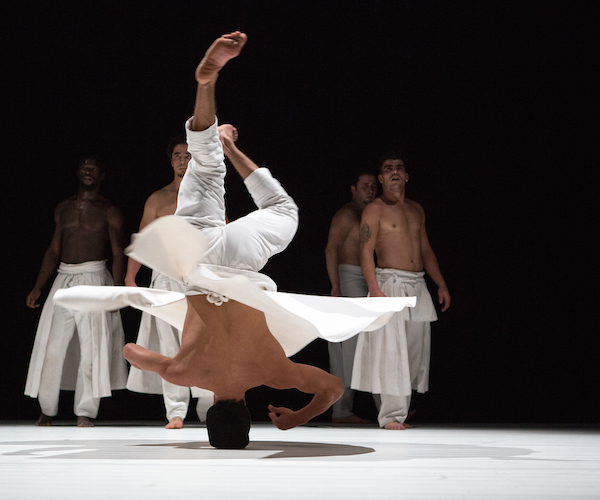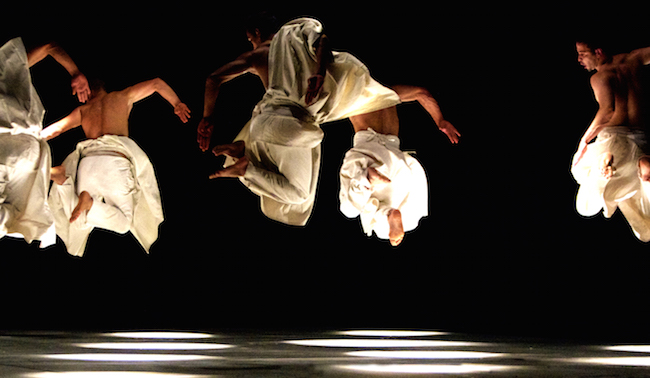Dance Review: Hurtling Through the Spheres — Compagnie Hervé Koubi
Koubi’s piece overturned expectations in so many ways it could be called innovative, groundbreaking—except I can’t imagine how it might develop further without losing its character.

A scene from Compagnie Hervé Koubi’s “Ce que le jour doit à la nuit.” Photo: Didier Phillispart
By Marcia B. Siegel
You’d expect a show touted for its hip hop and breakdance moves to provoke screams worthy of a sports event or a Trump rally. But no. Friday night’s performance of Ce que le jour doit à la nuit by Compagnie Hervé Koubi (presented by CRASHarts at Boston’s Institute of Contemporary Arts) was greeted by a respectful silence. Then, at the end, a heartfelt version of the pro forma standing ovation. The dance, choreographed by Hervé Koubi for a company of Algerian and African dancers based in southern France, was a kind of meditation for the performers and, I think, for the audience too.
Resisting the easy adulation of the usual applause-provoking hip hop show, Ce que le jour. . . incorporated the tricks in a larger framework of movement. It didn’t have the slick sexiness of contemporary dance either. Instead, the whole piece struck me as anti-ego, even anti-individual. It seemed to me to be an affirmation of multiculturalism and — beyond that — a communal journey with spiritual significance.
Koubi’s piece overturned expectations in so many ways it could be called innovative, groundbreaking — except I can’t imagine how it might develop further without losing its character. The 12 men were barechested but not hunky. Obviously strong, they didn’t have the sculptured bodies of trained dancers or athletes. They wore white trousers with white panels attached to the waist that flew out like skirts when they turned. They started the dance facing away from the audience, and didn’t beg for approval even when they were doing phenomenal feats.
The men assembled almost in the dark and lay down in a heap, in a pool of very dim lighting (by Lionel Buzonie). After that, they spread out, crawling, as the pool of light grew larger and brighter, until they were all standing facing upstage. We heard a low, muffled gong and later some lighter bells jingling, to the gong’s regular underlying beat. The dancers didn’t overtly follow the beat but, perhaps taking their own timing, began reaching up with one arm, stretching into backbends, and turning impossibly slow cartwheels.
Without perceptible cues, they walked from one place to another, in what seemed a plodding, purposeless way. Out of this slow-moving crowd, one or two people would erupt into no-handed double flips or back flips. After some minutes, I became aware of how elastic the timing was. When someone finished a flip or a one-handed cartwheel, I could see how the dancer would slow his movement down, or come to a stop, or modulate his momentum into a slide, but I couldn’t spot how these acrobatic moves sprung up out of the moving mass.
Koubi’s choreography also resists the formal expectations of contemporary dance: the technical lexicon of ballet or modern dance steps, the use of expressive gesture or storytelling. This dance doesn’t collect the moves into neat, metrical patterns or mold the bodies into clear linear shapes. The group is spread all over the space, facing in different directions, so you’re not prompted to look in any one direction or follow one pathway.
But certain ideas are embedded in the flow of the movement, ideas that recur in larger and larger forms. Unnoticed, dancers left the space and the population thinned down to smaller groups or pairs of dancers. It seemed the whole population was changing and reassembling all the time, although I do remember a couple of lineups that triggered off new rounds of turning, and many intense full stops.
Men spun their partners on their shoulders, they worked in tandem to bring off spacey cartwheels. Men were carrying other men on their backs and whirling them around, or pulling their partners around them on the floor. There were one-handed handstands that spun around. Small groups hove together to form temporary platforms so others could stand on their collective backs and flip off.

A scene from Compagnie Hervé Koubi’s “Ce que le jour doit à la nuit.” Photo: Lou Damars.
All of a sudden a man was standing on his head and whirling very fast, his legs changing positions in the air. Later there were two head-spinners at the same time. One man began the slow, spaceless turning of Sufi dervishes, and others joined him. Eventually the whole group was spinning in different ways, with the two head-spinners in the center of a whirling universe.
The group clusters became larger. Together they caught other men and threw them high in the air. At one point I thought there was a kind of war scene — none of it acted out but suggested, in a period of activity that resulted in slow falls to the ground. Very gradually, men bent over other men and tenderly helped them to rise as if caring for a wounded comrade.
All along, different music was fading in and out. The initial drums became a string ensemble that sounded Middle-Eastern (by Hamza El Din), then operatic voices from J.S. Bach’s St. John Passion, then Sufi music. As the Bach rose, the group clusters lifted one man into a high standing pose. He somehow fell or ran down or was carried across the space, where he fell into the arms of another group. I thought of this as the martyr sequence, maybe because of the Bach. It happened twice, but maybe not in the same way.
Then the whole group moved to the center and spread out to do headstands. They formed a chain, holding hands. Now the music returned to bells and drumming. The chain moved across the space, breaking into a half-circle that gave rise to small solo dances. There was more spinning and what I thought was a reprise of the war dance, to percussion and flute.
At last, the men were standing again, most of them facing away from the audience. One man was quietly chanting words I couldn’t make out — later I learned he was saying something like, “I have been there” — but it sounded like prayer.
Internationally known writer, lecturer, and teacher Marcia B. Siegel covered dance for 16 years at The Boston Phoenix. She is a contributing editor for The Hudson Review. The fourth collection of Siegel’s reviews and essays, Mirrors and Scrims—The Life and Afterlife of Ballet, won the 2010 Selma Jeanne Cohen prize from the American Society for Aesthetics. Her other books include studies of Twyla Tharp, Doris Humphrey, and American choreography. From 1983 to 1996, Siegel was a member of the resident faculty of the Department of Performance Studies, Tisch School of the Arts, New York University.
Tagged: Ce que le jour doit à la nuit, Compagnie Hervé Koubi, CRASHarts, Institute of Contemporary Arts
